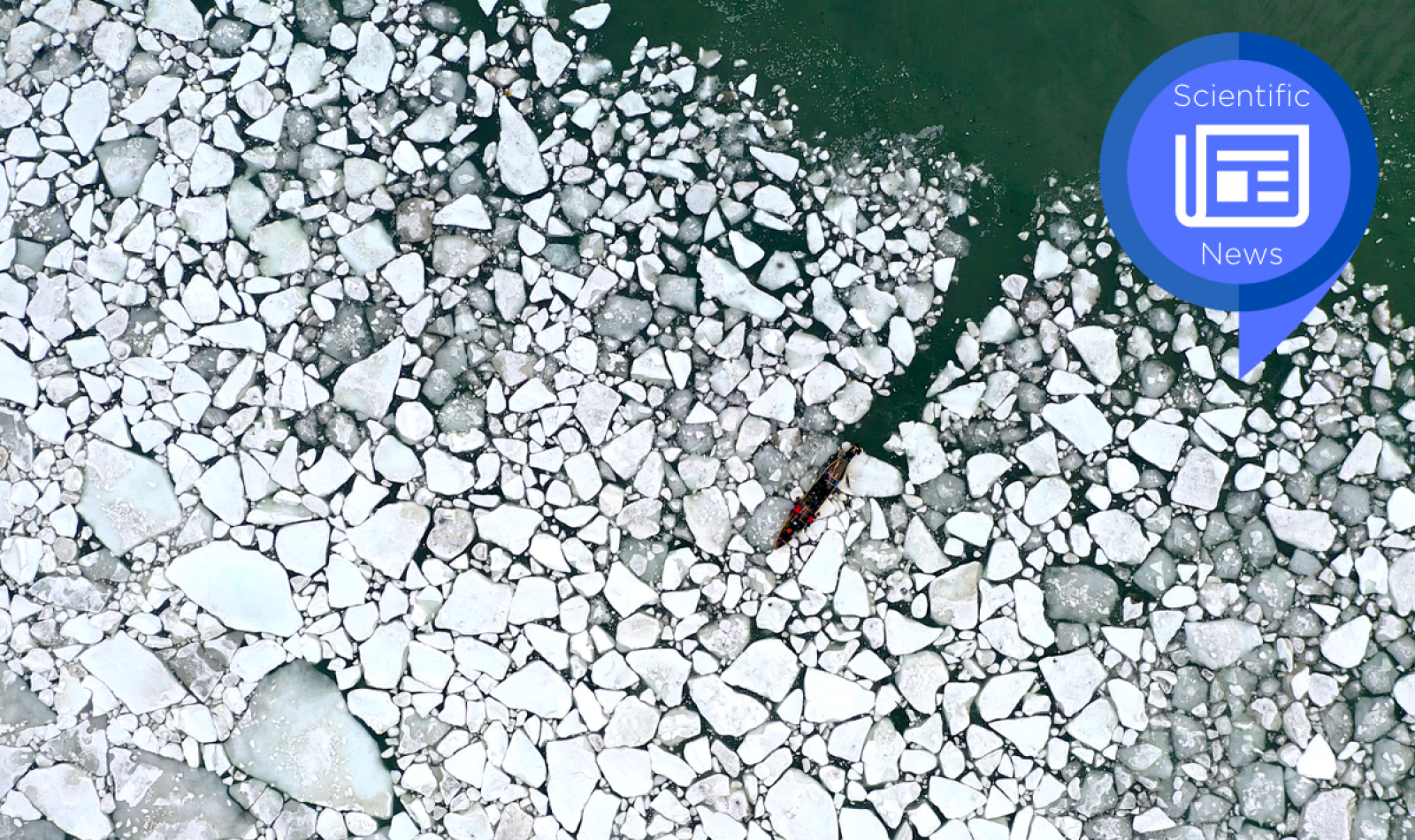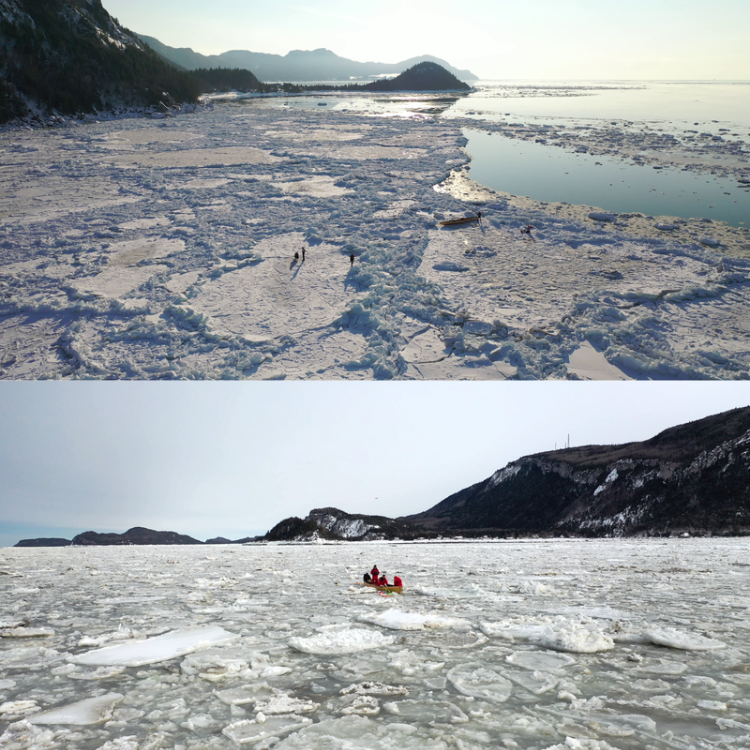
A physicist canoeing in the ice
An article by Valérie Levée, science journalist
If you see Dany Dumont canoeing through the ice, it's not just for sport. It's also for science. He has made sea ice his research focus.
In northern coastal areas, between the pack ice and the open water, there is a discontinuity where the ice dances with the sea. This is the ice margin, a heterogeneous zone made up of blocks of ice ranging from tiny frazil crystals to slabs of several tens of meters in diameter, all tossed about by the waves. This is the laboratory of Dany Dumont, a professor at the Institut des sciences de la mer at the Université du Québec à Rimouski.
"The ice margin is the zone of interaction between the waves formed in the ocean and the ice pack. The ice drifts with the movements induced by the waves until it encounters already consolidated ice or the coast," explains the physicist who studies the effect of waves on the dynamics of the ice pack.
If the sea is calm, the ice forms in a very thin layer, but as soon as a chop agitates the sea, the frazil agglomerates in small plates. As the wind strengthens and the waves become deeper, turbulent movements cause the frazil to swirl around. "If the waves are not very strong, the transition zone will not be very large. In Antarctica and the North Atlantic, large storms can affect the ice over tens or hundreds of kilometers," describes Dany Dumont.
Waves propagate in the ice margin, which is like an undulating sheet, loaded with frazil, ice cubes and blocks. But as the waves travel through the ice, they encounter resistance, and their kinetic energy dissipates. "The short waves fade quickly while the longer ones persist for an extended period of time," says Dany Dumont. Ice blocks absorb the energy of the waves, sometimes at the risk of breaking. Ice has a certain elasticity and can be deformed, but if the flexion exceeds the breaking point, it breaks.
In other cases, waves collide with large, solid blocks of ice and reflect off the ice as they would off the hull of a ship.
To add to the complexity of these dynamics, if the waves push the ice until it piles up, ice-free zones are created in the process. The exchanges between the ocean and the atmosphere are modified, because while ice reflects heat, water absorbs it.
To understand this complexity, Dany Dumont, a specialist in the physics of the ice pack, joined forces with Peter Sutherland, a researcher at the Ifremer Physical and Spatial Oceanography Laboratory in Brest and a specialist in turbulence and waves.
Canoeing on the ice
"We cannot study all these phenomena in the laboratory because it is difficult to form sea ice in the laboratory, but also because not all observations made in a small tank can be extrapolated on a large scale," comments Dany Dumont. For him, going to the field is synonymous with going to the ice margin and it is in a cove in Bic National Park that he has established his laboratory.
He started by installing a camera at the top of Pic Champlain with an image taken every 2 seconds to visualize the movement of the ice. But to measure the physical properties of the waves, you must be on site. "We go to the ice pack in a canoe, an eight-meter-long boat that allows us to navigate through all types of ice landscapes. We then install accelerometers on the ice blocks and record the movements induced by the waves," says Dany Dumont. He also installs underwater acoustic instruments to quantify the amount of energy dissipated by turbulence under the ice. "We know that wave energy is attenuated, but we don't know how much of it is dissipated by the deformation or breakup of the ice or by turbulence in the water or even by other mechanisms," he says.
Drones complete the observation process. Image analysis makes it possible to reconstruct wave propagation and to calculate the speed of movement of ice blocks. When two drones are used to capture stereoscopic images, vertical movements can also be evaluated.
Every winter, he spends a few weeks at Bic with his research team and enthusiastic volunteers, scampering across the ice and wading through the frazil. "You have to surround yourself with collaborators who are not afraid of the cold. In the ice soup, you can't paddle, and you can't lean firmly on the ice blocks either, so you must scramble with your legs to move the canoe forward," says Dany Dumont. It's demanding, but it's an incredible pleasure to be on the ice floe. The ice canoe is the magic part. It does me a lot of good when February comes around each year. I return from the field completely energized.
Better predicting ice formation
Dany Dumont has been studying the ice margin since 2009 and has seen how waves can be a major force in ice transformation. Yet this force is not considered in ice prediction models. "The models include the force of winds and currents, but not that of waves. We are trying to quantify wave movement to improve the models," says Dany Dumont. Knowing the state of the ice is important in many areas of our activities, including navigation and protecting infrastructure and shoreline subject to coastal erosion, but also mobility and safety in northern regions where the ice is a dominant landscape.

To learn more :
Dumas-Lefebvre, E. and Dumont, D. (2021). Aerial observations of sea ice break-up by ship waves. The Cryosphere Discuss, [preprint]
https://doi.org/10.5194/tc-2021-328
Dumont D. (2022). Marginal ice zone dynamics: history, definitions and research perspectives. Philosophical Transactions of the Royal Society, A 380: 20210253
https://doi.org/10.1098/rsta.2021.0253
Sutherland P. and Dumont, D. (2018). Marginal ice zone thickness and extent due to wave radiation stress. Journal of physical oceanography, 48: 1885-1901
https://doi.org/10.1175/JPO-D-17-0167.1
Dumont, D. A. Kohout, A, and Bertino, L. (2011). A wave‐based model for the marginal ice zone including a floe breaking parameterization. Journal of geophysical research, 116: C04001
https://doi.org/10.1029/2010JC006682
 Science News
Science News
Spotlight on Northern Research | An initiative of Institut nordique du Québec
To celebrate Quebec's excellence in northern research and to highlight the various challenges and issues related to these territories, Institut nordique du Québec offers you a series of articles dedicated to the research conducted in its community.
Over the months, you will discover a multidisciplinary research community whose strength lies in the complementary expertise of its members. You will meet individuals who share a strong attachment to the North and who are dedicated to producing, in collaboration with the inhabitants of the region, the knowledge necessary for its sustainable and harmonious development.
You are invited to relay this and subsequent articles to your network, thus enabling the greatest number of people to discover the different facets of northern research and the many faces that animate it. Together for the North!

